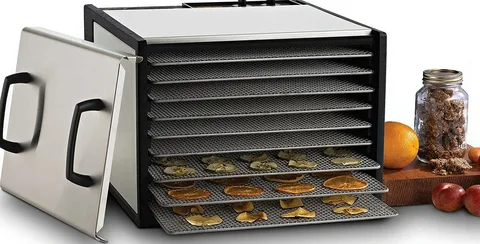The Excalibur-Dehydrator is a highly efficient kitchen tool, ideal for drying various foods such as fruits, vegetables, meats, and herbs. Its user-friendly design and high performance have made it a staple in many kitchens, especially for those focused on healthy eating and food preservation.
This device enables you to create tasty snacks, preserve seasonal produce, and experiment with new recipes. Its precision in drying ensures that nutritional content and natural flavours are maintained. Whether you’re a beginner or an experienced user, the Excalibur Dehydrator offers a reliable and straightforward way to dehydrate your favourite foods, enhancing their shelf life and convenience.
Unpacking and Setting Up
When you receive your Excalibur-Dehydrator, unpack all items carefully, including the dehydrator unit, drying trays, user manual, and any additional accessories. Slide the trays into their designated slots within the dehydrator unit. Place the appliance on a stable, flat surface, allowing ample ventilation. Ensure enough space around the unit to maintain optimal airflow and performance. Follow any initial setup instructions in the user manual, such as cleaning the trays before first use.
Navigating the Controls of the Dehydrator Excalibur Australia
The Dehydrator Excalibur Australia features user-friendly controls suitable for various foods. Start by familiarising yourself with the temperature settings, which typically range from 35°C to 68°C. Adjust the temperature according to the specific food you are drying. The timer function allows you to set the dehydrator to operate for a designated period, ensuring consistent results. Models often include a clear display for monitoring and adjusting settings easily.
Preparing Food for Drying
Choosing the right foods is essential for successful dehydration. Start with fresh, ripe produce and lean meats, washing and drying them thoroughly before proceeding. Uniform slices ensure even drying, so cut fruits and vegetables accordingly.
Arrange the slices in a single layer on the trays, allowing ample air circulation around each piece. For meats, consider marinating to add flavour before placing them on the trays. Ensure that pieces do not overlap, which can hinder proper drying. Different foods may require different preparations; for example, blanching vegetables can help retain their colour and texture.
Drying Fruits
When drying fruits, consider the natural sugar content and moisture level. Apples, bananas, and berries are popular choices. You can dip fruits like apples in lemon juice and water to prevent browning. Typically, fruits should dry at temperatures around 57°C. Drying times will vary; for example, apples may take 6-10 hours, while berries require 10-15 hours.
Drying Vegetables
Vegetables generally require a higher temperature setting of around 52°C. Blanching vegetables before drying can help preserve colour and texture. Cut vegetables like carrots and courgettes into thin, even pieces. Arrange them in a single layer on the trays, ensuring good air circulation around each slice. Drying times can range from 6 to 12 hours, depending on the water content and thickness of the slices. Monitor the drying process closely to avoid over-drying, which can make the vegetables too brittle. Once dried, store the vegetables in airtight containers in a cool, dark place to retain their freshness and flavour.
Crafting Jerky with Your Dehydrator
To make jerky with your Excalibur-Dehydrator:
- Start by selecting lean cuts of meat such as beef, turkey, or venison.
- Trim away any excess fat, as fat can hinder the dehydration process.
- Slice the meat into thin, uniform strips for even drying.
- Marinate the meat in your preferred seasoning mixture for at least 12 hours to enhance flavour.
- After marinating, place the strips in a single layer on the dehydrator trays, ensuring they do not overlap.
- Set the temperature to around 68°C.
Drying times typically range from 4 to 6 hours, but this can vary based on the strips’ thickness and the desired dryness level. Check periodically for the desired texture; the jerky should be firm but flexible.
Dehydrating Herbs and Spices
When drying herbs, it’s essential to use a lower temperature setting, typically between 35°C to 40°C. This range helps preserve the essential oils and nutrients in the herbs, ensuring that their vibrant flavours and aromatic qualities remain intact. The drying process at this temperature allows for gentle moisture extraction, preventing any degradation of the delicate compounds that give herbs their distinct tastes.
To achieve the best results, arrange the herbs in a single layer on the trays, ensuring they are not overlapping. This arrangement allows for proper air circulation, which is crucial for even drying and preventing mould growth. The drying time for herbs can range from 1 to 4 hours, depending on the herb type and the leaves’ thickness. Herbs like basil and parsley may dry quickly, while thicker-leafed herbs such as oregano or thyme may take longer.
Spices generally have a higher moisture content and require more drying time. It’s essential to monitor them closely and check for dryness regularly. Properly dried herbs should crumble easily between your fingers, indicating they are thoroughly dried. Spices, however, should be firm and brittle to the touch.
Once your herbs and spices are appropriately dried, transfer them to airtight containers to preserve their potency. Store these containers in a cool, dark place, away from direct sunlight or heat, to maintain their flavours and aromas. This drying method ensures that your herbs and spices remain a delightful and flavorful addition to your culinary creations.
Cleaning and Upkeep of the Excalibur Dehydrator Australia
Regular cleaning of your Excalibur Dehydrator Australia is essential for optimal performance. After each use:
- Remove and wash the drying trays with warm, soapy water and a soft brush to eliminate food residues.
- Rinse thoroughly and let them air dry completely before reinserting them into the unit.
- Wipe down the dehydrator’s interior and exterior surfaces with a damp cloth, avoiding electrical components and ventilation areas.
- Inspect the fan and heating elements periodically for any build-up of debris or dust.
- Use a dry brush or vacuum attachment to clean these areas if necessary.
Ensuring all components are clean and dry before reassembling will prevent mould growth or odours. Keeping your appliance well-maintained will enhance its longevity and ensure consistent drying results.
Resolving Common Problems
Common problems with the Excalibur-Dehydrator often stem from improper use or maintenance. If you notice uneven drying, check that the trays are not overloaded and are arranged to allow proper air circulation. Ensure the dehydrator is placed on a stable, flat surface with adequate ventilation.
If food takes too long to dry, verify that the temperature settings are correct for the food you are dehydrating. Regularly inspect the fan and heating elements for any debris obstructing airflow. Should your dehydrator produce unusual noises or fail to heat correctly, these could be signs of a mechanical issue, and consulting the user manual or contacting customer support is advisable. Ensure the trays and unit are clean before use to avoid contamination or flavours in your dehydrated foods. Keeping a routine check will help maintain the dehydrator’s efficiency and extend its lifespan.
Recipes and Inspirations
The Excalibur-Dehydrator is a fantastic tool for a range of creative recipes. One popular option is making fruit leather by blending fruits into a purée and spreading it thinly on the trays. You can also craft vegetable crisps using thin slices of courgettes, carrots, or beetroot lightly seasoned with herbs and spices. For a sweet treat, try dehydrating pineapple rings or strawberry slices. Beyond snacks, use your dehydrator to create flavourful dried herbs that can be ground into spices or added directly to dishes.
Experiment with homemade granola by dehydrating oats with honey, nuts, and dried fruits. Another delightful idea is making sun-dried tomatoes, perfect for adding to salads, pastas, or sandwiches. Dried mushrooms are excellent for soups and stews, providing an intense, earthy flavour. The Excalibur-Dehydrator opens numerous culinary avenues, encouraging you to explore and enjoy new food preservation techniques.
Conclusion
Using the Excalibur-Dehydrator allows you to enjoy the benefits of homemade, preservative-free dried foods, enhancing your diet and culinary creativity. This appliance’s flexibility means you can experiment with various foods, from fruits and vegetables to meats and herbs. By carefully selecting and preparing your ingredients, you ensure the best results, making your efforts worthwhile. This device is a valuable addition to any kitchen, offering convenience and health benefits. Enjoy discovering new flavours and textures and make the most of this appliance’s versatility.
Frequently Asked Questions
Can I dehydrate multiple foods at the same time?
– Yes, as long as the temperature and drying times are compatible. Be mindful of intense flavours that might transfer.
How should I store dehydrated foods?
– Store in airtight containers or vacuum-sealed bags in a cool, dark place to maximise shelf life.
Why is my food not drying evenly?
– Ensure trays are not overloaded and the dehydrator is on a stable, flat surface with adequate ventilation. Regularly check and rotate trays if necessary.
What temperature should I use for different foods?
– Use lower temperatures for delicate items like herbs and higher temperatures for meats and vegetables. Refer to the guidelines provided in the user manual for specific recommendations.
How often should I clean my Excalibur Dehydrator?
– Clean the drying trays and interior surfaces after each use to maintain hygiene and performance. Regular maintenance will prevent mould growth and ensure efficient operation.
| Related Business Listings |
| Contact Directory |
| Local Business Profiles |




